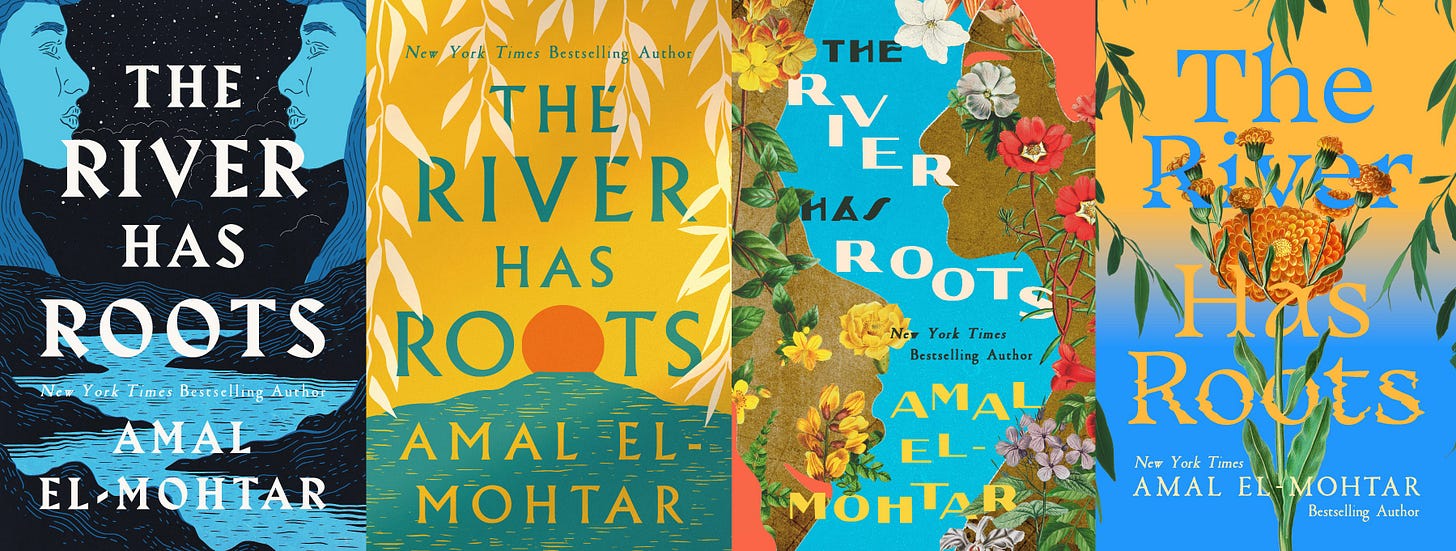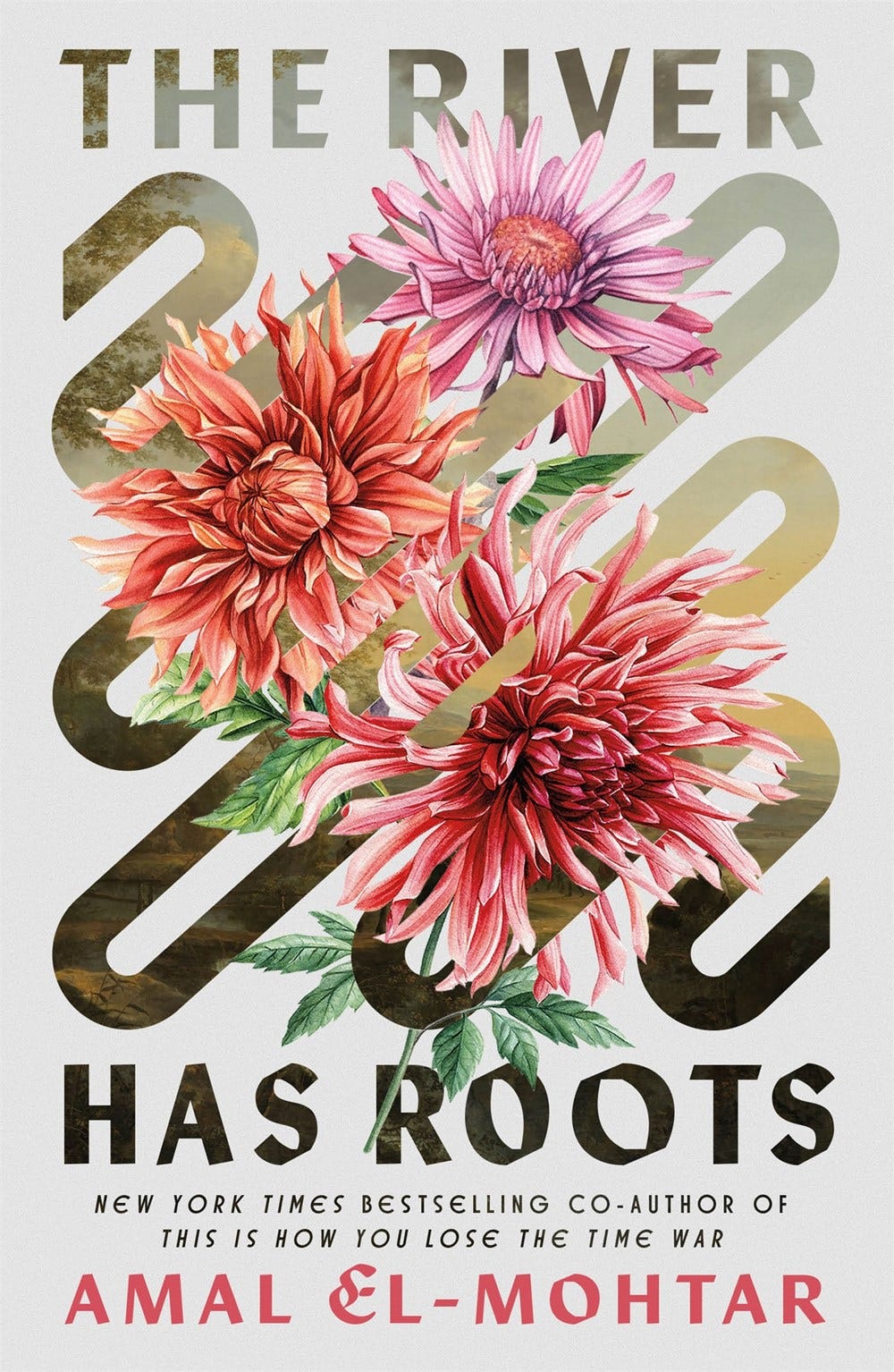Exclusive: For Amal El-Mohtar, grammar is magic
Behind the book: 'The River Has Roots,' a new fantasy novella with a bold cover design by Spencer Fuller.
Where were you when Bigolas Dickolas tweeted the Book Recommendation Heard ‘round the World?
I was in Chicago’s O’Hare Airport. When I saw this tweet on my phone, I went straight into Barbara’s Bookstore to buy a copy.
Thousands of people did the same thing, and This Is How You Lose the Time War — a short, clever epistolary novel where science fiction and fantasy collide — became a bestseller four years after it had been published.
I read the whole thing on my flight and loved it.
Now, one of the co-authors — Amal El-Mohtar, whose reviews I’ve always enjoyed at NPR and the NYT — is back with her solo debut. The River Has Roots is a gorgeous, prosaic fantasy adventure about Esther and Ysabel Hawthorne, two sisters who care for ancient trees in the town of Thistleford, which sits near the borders of Faerie. When one of the sisters gets romantically involved with a Faerie suitor, things take a turn for the worse.
El-Mohtar is one of our finest crafters of sentences, and this book features a magic system called Grammar, inspired by her own love of words.
The River Has Roots was one of my most anticipated books of 2025 over at Esquire, and for good reason — it’s fantastic. If you like concise speculative fiction with a strong sense of style, atmosphere, and world-suggesting, you’ll love it, too.
I spoke with Amal El-Mohtar and one of my new favorite cover designers, Spencer Fuller, about bringing this book to life.
Amal El-Mohtar
Where did you write most of this book?
I’ve moved house twice since I started writing it, and since moving I found myself mostly writing it in goblin-esque positions on a couch or dining room table. But this is the desk where it was begun, though it’s in a space three homes ago.
Does the process of writing feel like wielding a system of magic to you? Did that inspire the nature of grammar in the book?
Honestly it does feel like wielding a system of magic! What are we doing, in books, if not casting a spell on a reader and provoking them into hallucinating vividly some part of another world?
Something I've often said in workshops is that if poetry breaks language into meaning (my deliberate mangling paraphrase of T. S. Eliot), fantasy breaks reality into truth. So, grammar is a means of ordering or organizing thought and communication; but that ordering can be programmatic or it can be playful, denotative or evocative, comforting or provoking.
What was the hardest part about writing this book?
There were two big prongs of difficulty: the first was in getting started, and the second was in revision. My harp teacher, Hoda Nassim, to whom the book is partly dedicated, passed away while I was outlining it, and I’d been so looking forward to sharing it with her that it just knocked the wind out of me.
Then when I was invited to expand the story to novella length, the revision involved trying to hold on to the story’s essence while transforming its body significantly — thematically appropriate, but very hard to do!
My husband found the key to it, though, by telling me to take the advice I usually give to students, and read it all out loud. Once I did that, the possibilities for developing layers and dimension in the story while preserving its tone and focus really emerged.
Was The River Has Roots always the title? What made it a perfect fit in the end?
In fact no — my working title was Two Sisters, and then briefly Harp Swan Sister, but once I had a full draft, I was brainstorming with my agent (DongWon Song) and editor (Ali Fisher), and somewhere between them they landed on The River Has Roots, which just made my heart sing.
In fact once the title was in place, I ended up revising the text to include it, because it already felt like so much a part of the texture of the story that I just wanted to bring it into sharper relief.
Spencer Fuller, cover designer
Can you share some alternate cover designs and explain why they didn't make the cut?
I wasn’t the original designer working on this project but the title caught my eye and I asked about the book and he tried to describe it as mythological and pastoral which sold me and I asked to throw in on the presentation.
Most of the initial covers we presented were representational but felt a little like classical mythology. The artwork was very specific to the story in most cases and definitely carried the folklore feel of the book but in some ways felt limited by their tone. My design was the one honed in on and I’m really grateful for the opportunity to make something beautiful.
What did you want the cover art to convey about the book?
What initially drew me to the project was the title itself and the imagery that it evokes; I wanted to somehow capture that feeling in the cover design. This idea of a far-reaching and deep river, with all of its tributaries and offshoots felt like looking at a hydrological map in my head. I set out to represent this idea as simply as I could and then pair it with floral elements to connect it more to the imagery in the book as well as drawing the eye in with a slightly overstimulating look.
Why was the final cover art the right choice?
What I really like about the approved cover is how difficult it is to place it in a specific setting, leaving a few visual hints to make the viewer curious to know more. I love design that leaves something to be discovered, both in the cover itself but also because of the content the cover represents and I think this cover ended up doing a really good job of that. I ended up with one of the best covers I think I’ve made to date and I need to thank the author for such a unique platform to design from!
Forthcoming in The Frontlist
Behind the book with Stephen Graham Jones, author of The Buffalo Hunter Hunter (Saga Press, March 18)
Behind the book with Nicholas Binge, author of Dissolution (Riverhead, March 25)
Behind the book with Vauhini Vara, author of Searches: Selfhood in the Digital Age (Pantheon, April 8)
April book preview







